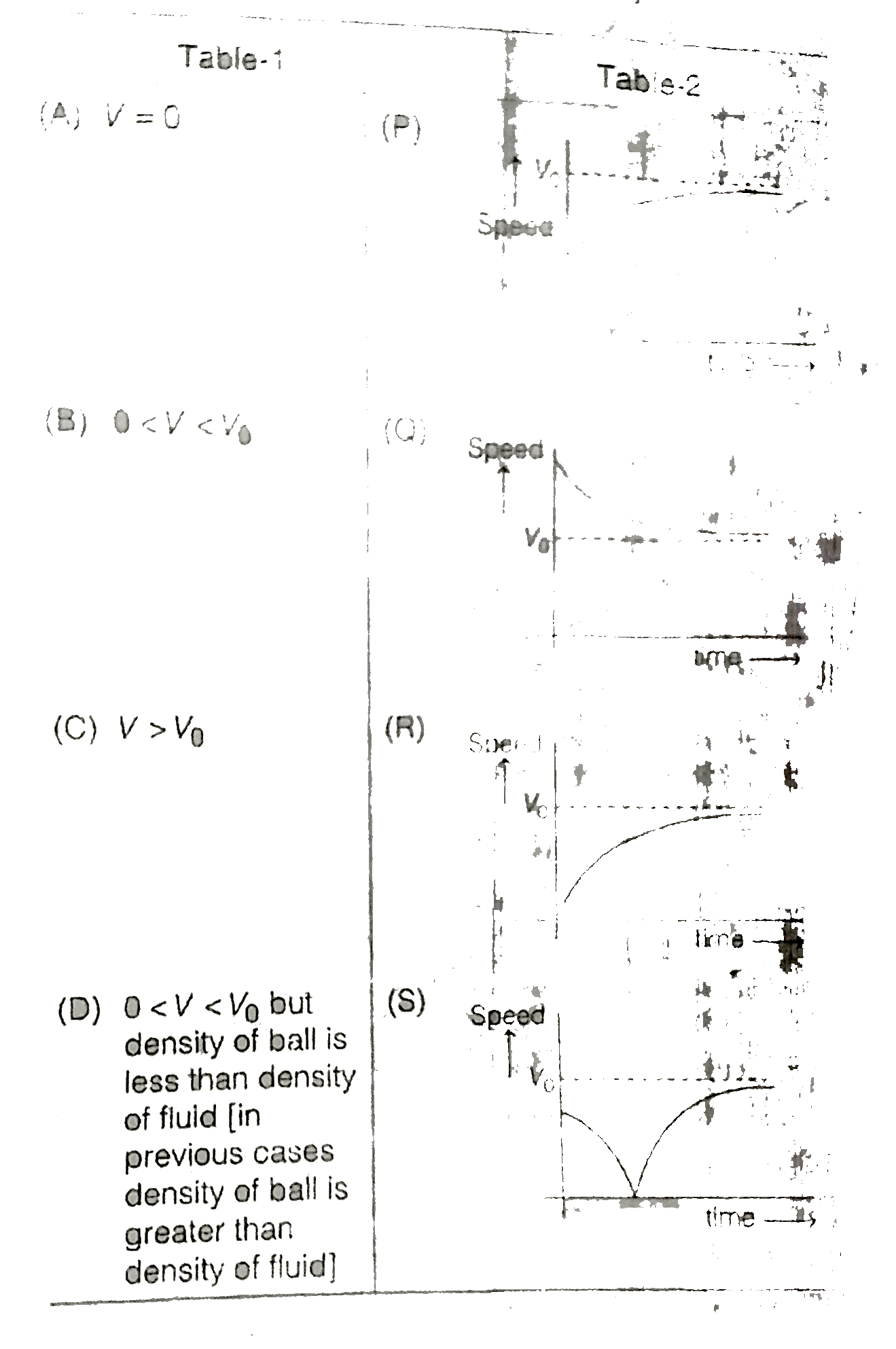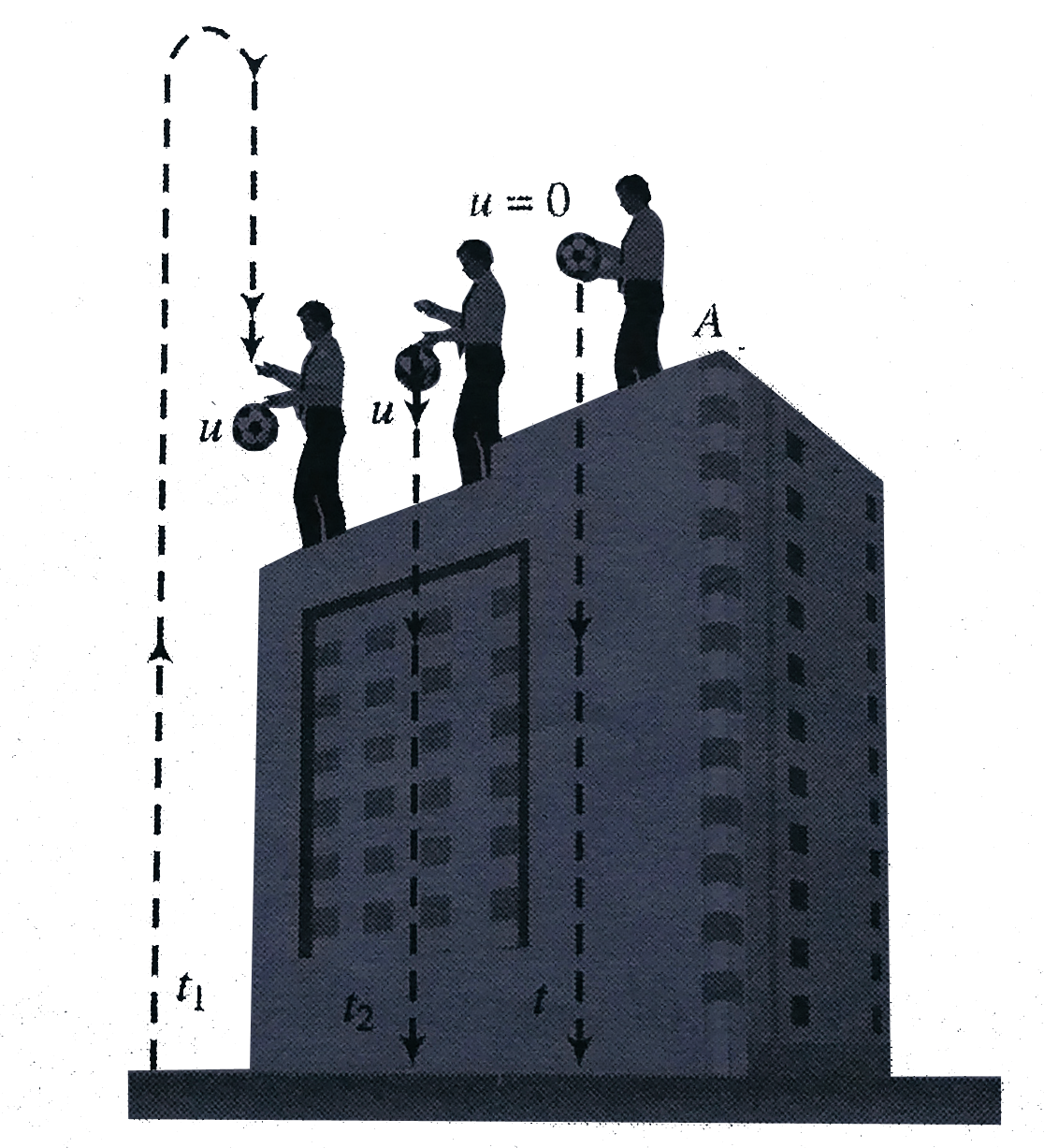From a building two balls A and B are thrown such that A is thrown upwards and B downwards ( both vertically with the same speed ). If vAandvB are their respective velocities on reaching the ground , then
vB>vA
vA=vB
vA=vB
their velocities depend on their masses.
The correct Answer is:B
To solve the problem, we need to analyze the motion of both balls A and B when they are thrown from the building.
1. Identify the Initial Conditions:
- Let the initial speed of both balls (A and B) be u.
- Ball A is thrown upwards, and Ball B is thrown downwards.
2. Analyze Ball A:
- When ball A is thrown upwards, it will first move up until it reaches its highest point and then fall back down to the ground.
- The height of the building is h.
- At the highest point, the velocity of ball A becomes 0.
- The total distance it travels upwards is h+h′ (where h′ is the height it reaches above the building).
- Using the third equation of motion:
v2A=u2−2g(h+h′)
- When it falls back down to the ground, it will cover the height h+h′ again.
3. Calculate Final Velocity for Ball A:
- The final velocity vA when it reaches the ground can be expressed as:
v2A=u2+2gh
- Therefore, we can write:
vA=√u2+2gh
4. Analyze Ball B:
- Ball B is thrown directly downwards with the same initial speed u.
- The distance it travels to reach the ground is h.
- Using the third equation of motion:
v2B=u2+2gh
- Therefore, the final velocity vB when it reaches the ground can be expressed as:
vB=√u2+2gh
5. Compare the Velocities:
- From the equations derived:
vA=√u2+2gh
vB=√u2+2gh
- This implies:
vA=vB
Conclusion:
The velocities of both balls A and B when they reach the ground are equal:
vA=vB
- Let the initial speed of both balls (A and B) be u.
- Ball A is thrown upwards, and Ball B is thrown downwards.
- When ball A is thrown upwards, it will first move up until it reaches its highest point and then fall back down to the ground.
- The height of the building is h.
- At the highest point, the velocity of ball A becomes 0.
- The total distance it travels upwards is h+h′ (where h′ is the height it reaches above the building).
- Using the third equation of motion:
v2A=u2−2g(h+h′)
- When it falls back down to the ground, it will cover the height h+h′ again.
- The final velocity vA when it reaches the ground can be expressed as:
v2A=u2+2gh
- Therefore, we can write:
vA=√u2+2gh
- Ball B is thrown directly downwards with the same initial speed u.
- The distance it travels to reach the ground is h.
- Using the third equation of motion:
v2B=u2+2gh
- Therefore, the final velocity vB when it reaches the ground can be expressed as:
vB=√u2+2gh
- From the equations derived:
vA=√u2+2gh
vB=√u2+2gh
- This implies:
vA=vB
The velocities of both balls A and B when they reach the ground are equal:
vA=vB
Topper's Solved these Questions
- MOTION IN A PLANE BOOK - NCERT FINGERTPS ENGLISHCHAPTER - MOTION IN A PLANE EXERCISE - HOTS
6 Videos
- MOTION IN A PLANE BOOK - NCERT FINGERTPS ENGLISHCHAPTER - MOTION IN A PLANE EXERCISE - EXEMPLER PROBLEMS
9 Videos
- MECHANICAL PROPERTIES OF SOLIDSBOOK - NCERT FINGERTPS ENGLISHCHAPTER - MECHANICAL PROPERTIES OF SOLIDSEXERCISE - Assertion And Reason
15 Videos
- MOTION IN A STRAIGHT LINEBOOK - NCERT FINGERTPS ENGLISHCHAPTER - MOTION IN A STRAIGHT LINEEXERCISE - NCERT Exemplar
6 Videos
Similar Questions
From the top of a tower body A is thrown up vertically with velocity u and another body B is thrown vertically down with the same velocity u.If VA and VB are their velocities when they reach the ground and tA and tB are their times of flight ,then
View SolutionA person standing near the edge of the top of a building throws two balls A and B. The ball A is thrown vertically upward and B is thrown vertically downward with the same speed. The ball A hits the ground with speed vA and the ball B hits the ground wiht a speed vB. We have
View SolutionTwo balls X and Y are thrown from top of tower one vertically upward and other vertically downward with same speed. If times taken by them to reach the ground are 6 s and 2 s respectively, then the height of the tower and initial speed of each ball are (g=10m/s2)
View SolutionA ball is thrown vertically upwards from the ground. If T1 and T2 are the respective time taken in going up and coming down, and the air resistance is not ignored, then
View SolutionTwo balls AandB of same masses are thrown from the top of the building A. Thrown upward with velocity VandB, thrown downward with velocity V, then
View SolutionA ball is thrown downward In a viscous fluid with speed V. Terminal speed of ball is V0

View SolutionTwo balls of different masses (one lighter and other heaver) are thrown vertically upwards with the same speed. Which one will pass through the point of projection in the downward direction with greater speed?
View SolutionA ball is thrown upwards into air with a speed greater than its terminal speed. It lands at the same place from where it was thrown. Mark the correct statement (s).
View SolutionA body is thrown vertically upwards from A. The top of a tower . It reaches the ground in time t1. It it is thrown vertically downwards from A with the same speed it reaches the ground in time t2, If it is allowed to fall freely from A. then the time it takes to reach the ground.
 .
.
View SolutionA body is thrown vertically upwards from A. The top of a tower . It reaches the ground in time t1. It it is thrown vertically downwards from A with the same speed it reaches the ground in time t2, If it is allowed to fall freely from A. then the time it takes to reach the ground.
 .
.
View Solution
